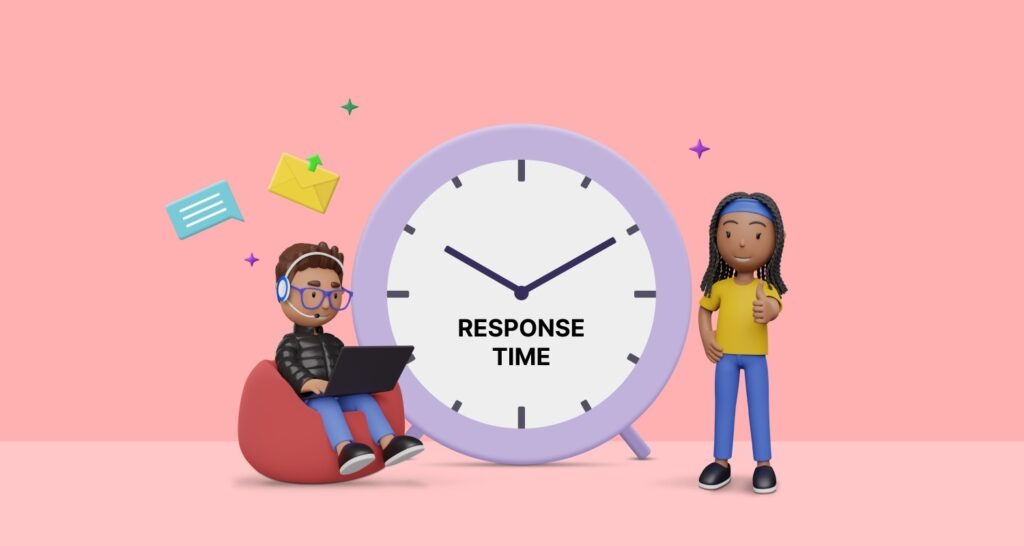Benefits Of Improving First Response Time

Businesses can significantly enhance the customer service experience and distinguish themselves from competitors by improving response times. Focusing on achieving optimal response times can deliver the following rewards to your company:
Improve customer service efficiency
Efficiency means accomplishing more tasks in less time without exhausting your agents. Prioritizing response and resolution times ensures agents concentrate on essential tasks. Service representatives manage their schedules effectively and handle a higher number of tickets than the average agent.
Improved customer satisfaction is associated with a low first response time. Knowing the first response time helps support team leaders identify necessary actions to decrease it and prevents customers from experiencing long wait times that may lead to frustration. Dissatisfied customers are more likely to switch to a competitor.
Boost customer loyalty
Prioritizing customer service is crucial for brands as it engages customers and attracts potential customers. The loyalty of customers toward big brands like Apple is a testimony to this fact. By providing prompt support, brands can improve the overall customer experience, satisfy customers, and ensure customer retention. It is the positive customer experience that encourages customers to return.
Enhance customer satisfaction and agent efficiency
Customer service excellence doesn’t always entail resolving a customer’s issue on the first contact. Sometimes, acknowledging their email and informing them that you’re working on a solution is sufficient to keep them satisfied temporarily while also allowing your customer service team some breathing room.
If the problem cannot be solved right away, your primary objective when responding initially is to recognize the customer’s issue, inform them that a representative has been assigned to their ticket, and give them a timeframe for when they can anticipate a solution.
By sending a comprehensive initial response, you can ensure that customers remain content and understanding while your team focuses on their follow-up.
Reduce support team workload
Although achieving fast response times may seem daunting, slow responses can actually increase the workload of your customer support team. If you fail to assist a customer promptly, they may contact your company multiple times through various channels, resulting in multiple support tickets for a single issue. This can overwhelm your team and cause unnecessary confusion, which could have been avoided by responding to the initial query promptly.
Quicker resolutions make more money
There are numerous situations wherein promptly addressing a customer’s inquiry can result in increased revenue for your business. For instance, if a customer has a query about your product, responding swiftly could prevent them from exploring alternate products, potentially resulting in a sale that you may have otherwise missed out on.
Improve your company’s reputation
Your brand image can suffer due to slow response times, regardless of whether it is fair. As a business, it is important to foster brand loyalty and maintain returning customers, but slow response times can impede this goal.
Bear in mind that customers anticipate rapid response times due to the abundance of companies that can fulfill those expectations. If your company fails to keep up with the customer service standards set by your competitors, your brand reputation will be negatively impacted.
Potential buyers will also take notice of a company that provides exceptional service. Your market and rivals will acknowledge your brand as one that responds promptly to customer needs.
Higher customer satisfaction
Providing a prompt solution results in a favorable brand reputation and promotes customer satisfaction. When satisfaction scores are elevated, customer lifetime value is also increased. If you respond to your customers promptly, it indicates that you value their concerns, prioritize their needs, and go beyond their anticipated level of service.
Better handle changes in ticket volumes
By monitoring and analyzing the first response time, you can develop strategies for agent productivity, staffing levels during peak periods or outages, scaling up or down for seasonal demands, and other factors.
Develop empathy in your support staff
By correlating the first response time with customer satisfaction, you can gain valuable insights into how customers react to long waiting times. A high first response time can lead to customer churn and negative word-of-mouth, whereas a low one can leave customers feeling satisfied and happy.
It is a common misconception among customer service representatives that they can delay responding to a question until they have all the necessary information. Even if agents are waiting for more information from the customer, it is vital that the customer and their problem be acknowledged promptly. Because the first response time indicates how quickly customers are informed that their problem is being addressed, it is often more critical than the overall resolution time.